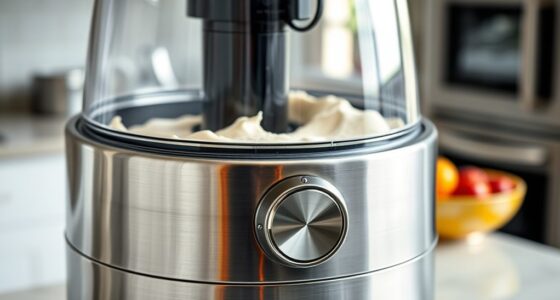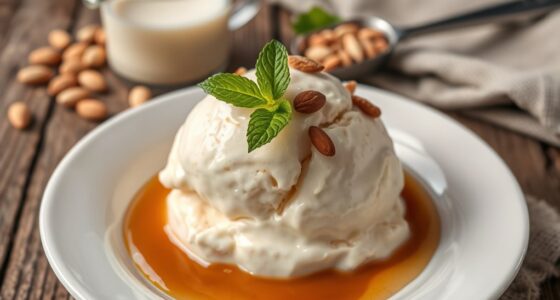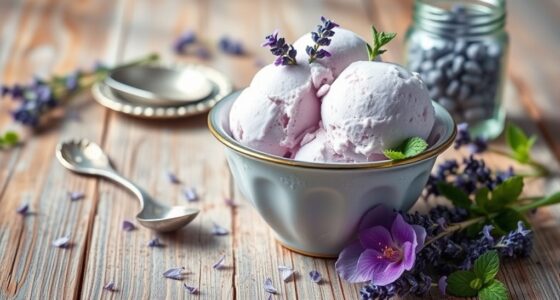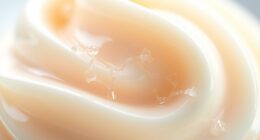To achieve the perfect scoop texture, balance your ingredients carefully by using milk, cream, and sugar in the right ratios. Control freezing points by incorporating air and managing temperature during churning. Emulsifiers help stabilize your mixture, while aging your ice cream base enhances creaminess and reduces ice crystals. Pre-chill your mix-ins and add them quickly to maintain texture. If you want to learn other advanced techniques and tips, there’s more to uncover!
Key Takeaways
- Use a balanced mix of milk, cream, and sugar to enhance flavor and maintain scoopability.
- Incorporate thickeners like tapioca starch to prevent ice crystal formation and improve texture.
- Age the ice cream base for at least four hours at 2-5°C to enhance creaminess and stability.
- Maintain consistent temperatures during the churning process to achieve a smooth and creamy texture.
- Pre-chill mix-ins before adding them to prevent melting and ensure a cohesive scoop.
Understanding Balanced Ingredients
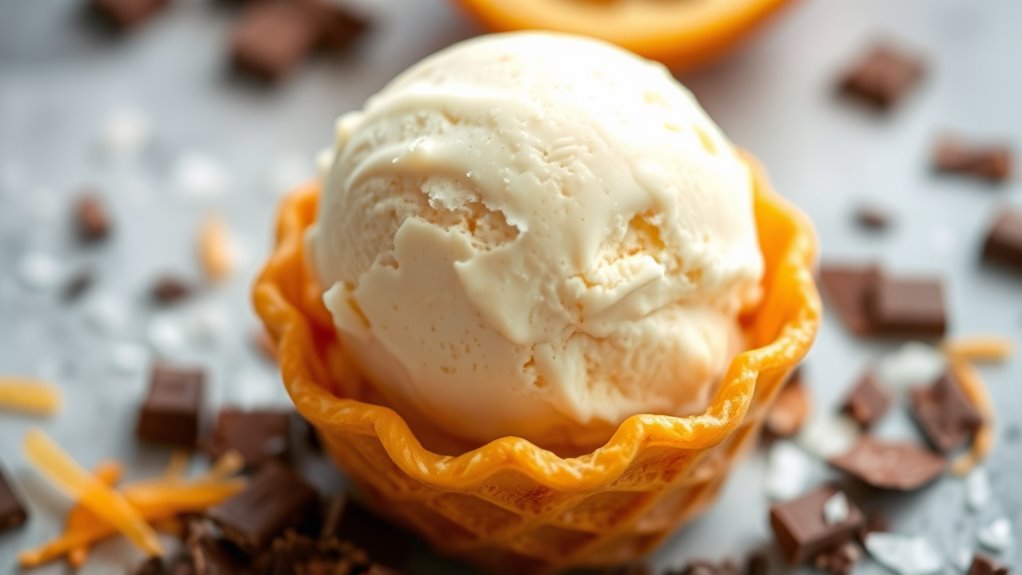
When you want to achieve that perfect scoop texture in your ice cream, understanding the balance of ingredients is essential.
Start with milk and cream, which coat ice crystals and prevent their growth, ensuring smoothness. Sugar plays a dual role: it enhances flavor and maintains scoopability by absorbing water. Aim for roughly three-quarters of a cup of granulated sugar per 475 mL of cream for ideal results. Fresh orange juice can also be a great addition to enhance flavor while keeping the texture creamy. Additionally, incorporating Dirt Cups as a playful dessert can inspire your ice cream flavors and make for a fun presentation.
Start with milk and cream to ensure smoothness, and use sugar to enhance flavor and maintain scoopability.
Don’t forget about fat—high-fat content from heavy cream or whole milk boosts creaminess and helps incorporate air during churning. Thickeners like tapioca starch can also improve texture by preventing unwanted ice crystal formation. Incorporating high-fat dairy products can significantly enhance the richness of your ice cream.
Balancing these elements will give you the delightful consistency you crave in your homemade ice cream.
The Science of Freezing Points
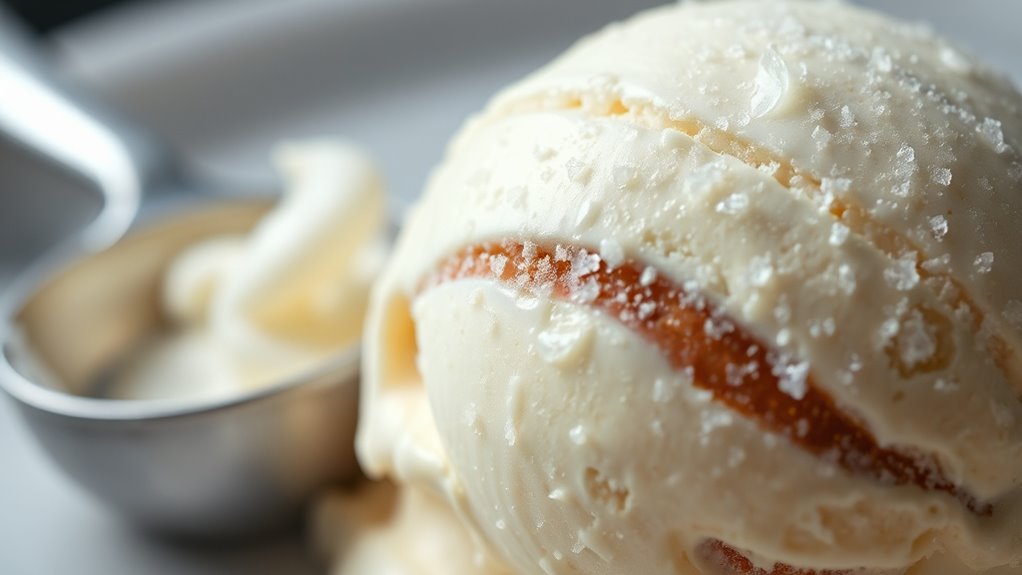
Achieving the perfect scoop texture in ice cream hinges on understanding the science of freezing points.
Freezing point depression (FPD) occurs when you add solutes like sugar, effectively lowering the freezing temperature of your mixture. This is vital for creating a scoopable consistency. The amount of solute you use matters—more particles lead to greater FPD. Additionally, incorporating solar energy into your ice cream production process can contribute to energy efficiency and sustainability. AI technologies are also being explored to optimize flavor profiles and texture in food production.
Sugar plays a significant role in this, while salt helps cool the mixture efficiently. Remember, higher concentrations enhance the effect, increasing entropy and requiring lower temperatures to freeze.
Nucleation, the formation of small ice crystals, is also essential for smooth texture. By mastering these principles, you can guarantee your ice cream remains creamy and easy to scoop, avoiding those pesky large crystals. Additionally, incorporating frozen fruit blends can introduce unique flavors while maintaining the desired texture.
Techniques for Churning and Temperature Control
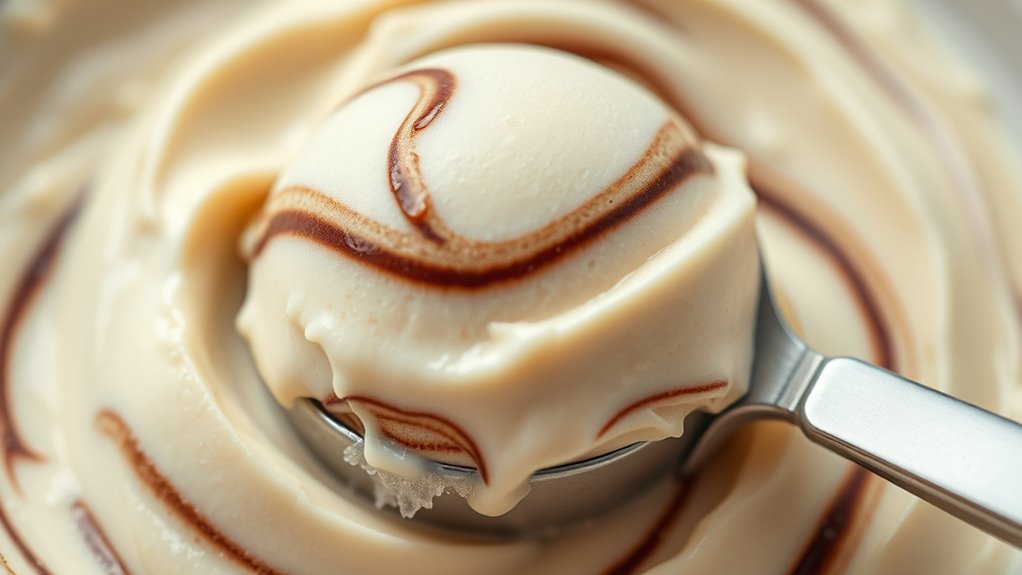
To create the perfect scoop texture in your ice cream, mastering techniques for churning and temperature control is crucial.
Using an ice cream maker helps incorporate air and break down ice crystals for a smooth finish. If you’re churning by hand, stir vigorously every 30 minutes while freezing to maintain consistency. It’s essential to be aware that ice cream contains high sugar content, so balance your ingredients accordingly.
Make certain your freezer bowl is pre-frozen for at least 24 hours to facilitate quick chilling. When churning, maintain an even speed to promote uniform ice crystal formation. Interestingly, ice cream is the most popular frozen dessert in the U.S., and understanding its ice cream terminology can enhance your preparation process.
Heat your mix to 72°C (162°F) for 25 minutes to enhance texture, and cool custards thoroughly before churning to prevent premature ice crystal formation. Additionally, using a custard base technique can elevate the creaminess and richness of your ice cream.
These steps will considerably improve your ice cream’s texture and creaminess.
The Role of Emulsifiers in Ice Cream
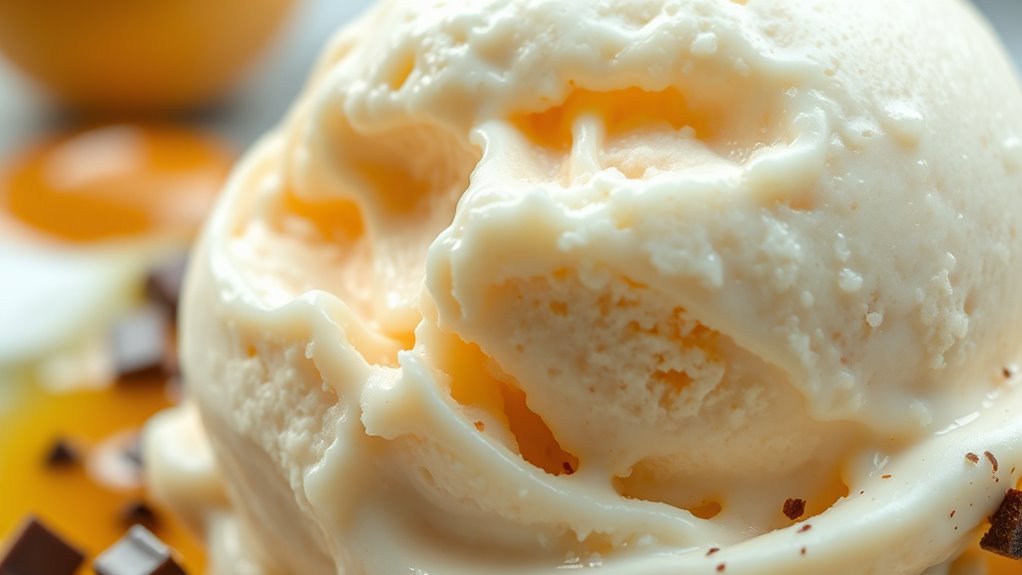
Emulsifiers play a pivotal role in crafting smooth and creamy ice cream, as they stabilize the delicate balance between fat and water in your mixture. Common emulsifiers like mono- and diglycerides, polysorbates, and sorbitan esters enhance texture, prevent separation, and improve shelf life. By breaking down fat globules into smaller sizes, they guarantee a uniform distribution of ingredients, making your ice cream lighter and airier. Additionally, incorporating chia seeds into your ice cream can enhance its nutritional profile while maintaining a smooth texture. Emulsifiers also prevent ice crystal formation, resulting in a smoother texture that melts slowly. The right blend, often a mix of polysorbate 80 and mono- and diglycerides, optimizes performance. Additionally, their use is crucial in creating popular ice cream flavors like Birthday Cake and Neapolitan, which rely on a stable texture for the best tasting experience. Many restaurants with live music also feature unique desserts, including artisanal ice creams that benefit from these emulsifying techniques.
Managing Add-ins and Mix-ins
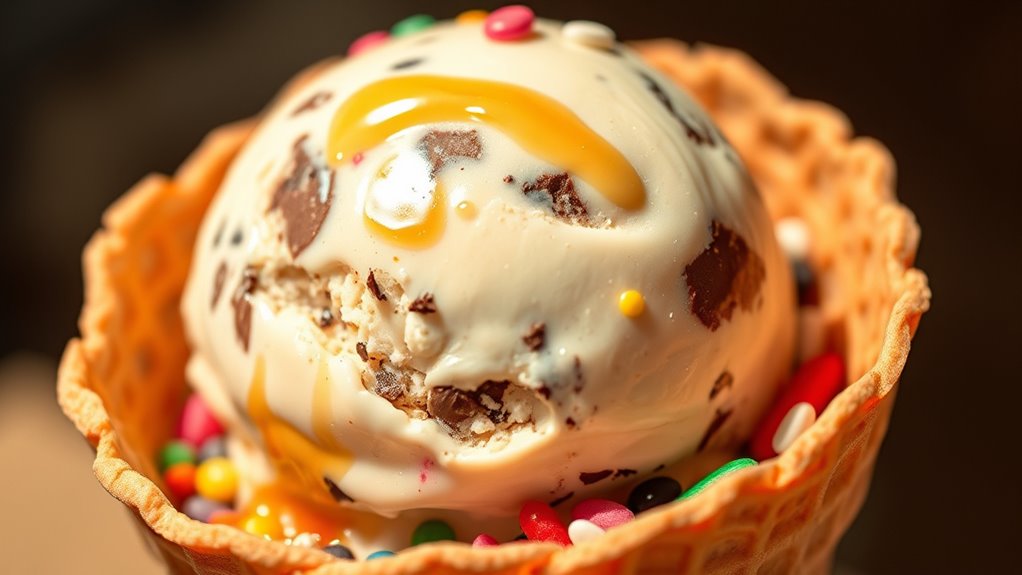
When it comes to creating the perfect ice cream, effectively managing your add-ins and mix-ins can make all the difference.
Start by controlling the temperature; pre-chilling your mix-ins helps maintain texture and prevents melting. Add them quickly while the ice cream is still churning to avoid any disruption.
Use a layering technique for syrups and sauces to create beautiful swirls without mixing them in completely. Cocoa’s caffeine content varies based on processing methods, so consider this when adding chocolate elements to ensure a balanced flavor profile. Balance the quantity of mix-ins with your ice cream flavor to guarantee each scoop is delightful. Incorporating frozen yogurt pops as a mix-in can also provide a unique texture and refreshing taste.
Finally, consider the quality of your mix-ins—store them properly and manage moisture to keep their integrity intact. Additionally, incorporating high-quality espresso beans can elevate your ice cream experience by adding a rich flavor dimension.
Advanced Techniques for Flavor and Texture Enhancement
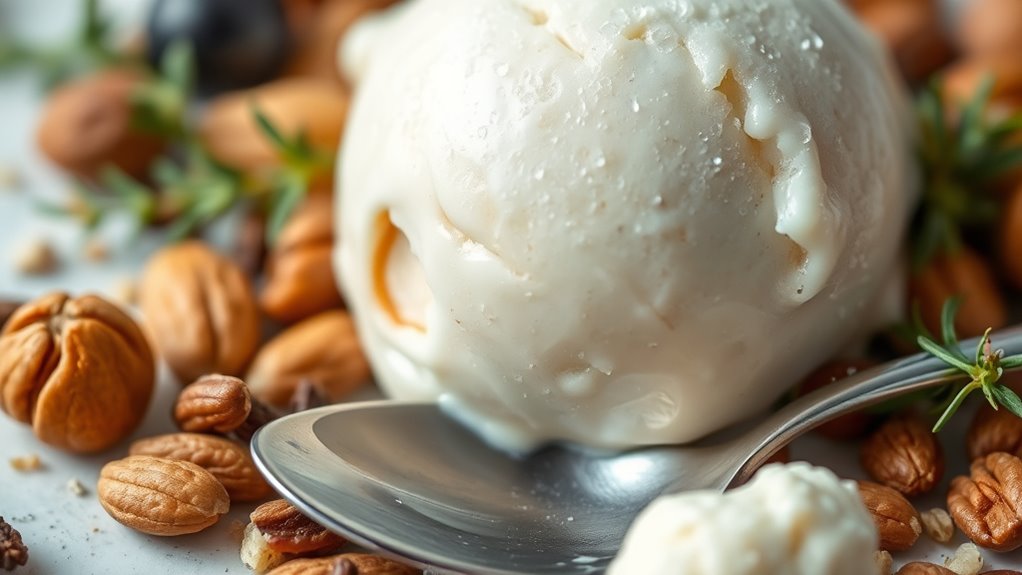
Mastering the perfect scoop texture is just the beginning; enhancing flavor and texture takes your ice cream to another level.
Start with a custard base, cooking egg yolks with sugar and milk for added richness. Use infusion techniques by gently heating milk or cream with spices or herbs to create complex flavors. Essential oils can also provide unique flavor profiles when used in moderation. Understanding the role of fat and sugar balance in ice cream formulation is crucial for achieving the desired texture.
Balance fat and sugar carefully—too much fat makes it heavy, while too little results in ice crystals. Incorporate natural emulsifiers like egg yolks and stabilizers such as cornstarch to maintain creaminess.
Control freezing temperature to limit ice crystal formation, ensuring a smoother texture. Experiment with sweet, salty, sour, and umami components for depth, and remember, serving at ideal temperatures enhances flavor perception. Additionally, consider using essential oils for flavor enhancement to introduce unique and aromatic notes to your ice cream.
Tips for Aging the Ice Cream Base
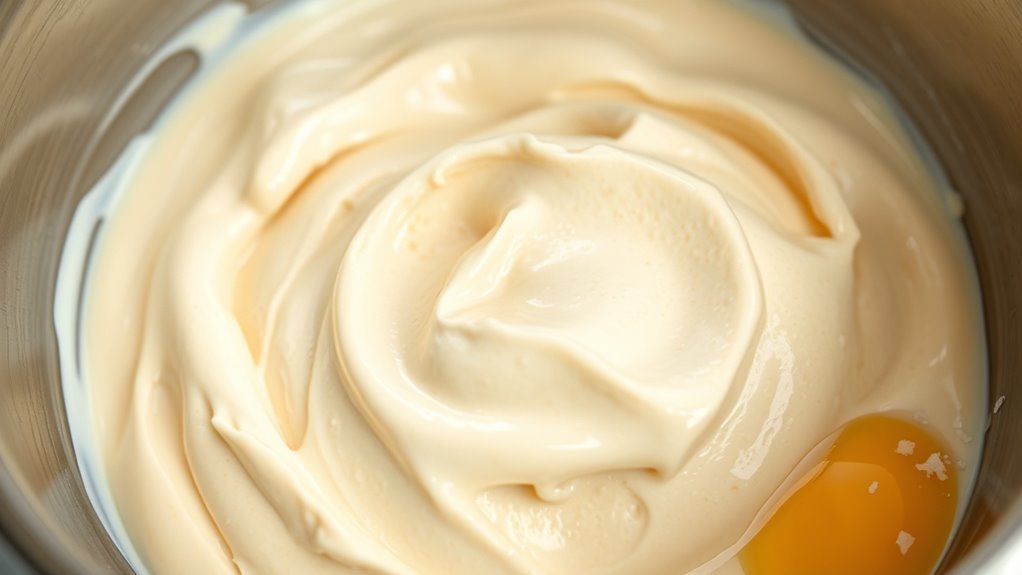
Aging the ice cream base is essential for achieving a smooth and creamy texture, so paying attention to temperature and duration is key.
Keep your mix at a low temperature, ideally between 2-5°C, for at least four hours, though overnight is even better for flavor and texture development. This process is similar to how wood-burning stoves enhance heating efficiency in a home by allowing for optimal performance. Additionally, using butter’s role in flavor can significantly contribute to the overall richness of your ice cream base.
This aging process allows proteins and emulsifiers to hydrate fully, enhancing stability and whipping qualities. You’ll notice that the mixture thickens slightly, improving churning performance and reducing ice crystal formation.
Use insulated tanks to maintain consistent temperatures, and consider gentle vibration to aid emulsifier hydration. Strain and cover your mix to prevent air exposure and lumps, ensuring a perfectly aged base ready for churning and scooping. Additionally, incorporating healthy fats during the aging process can further enhance the creaminess of the final product.
Experimenting With Sweeteners for Optimal Flavor
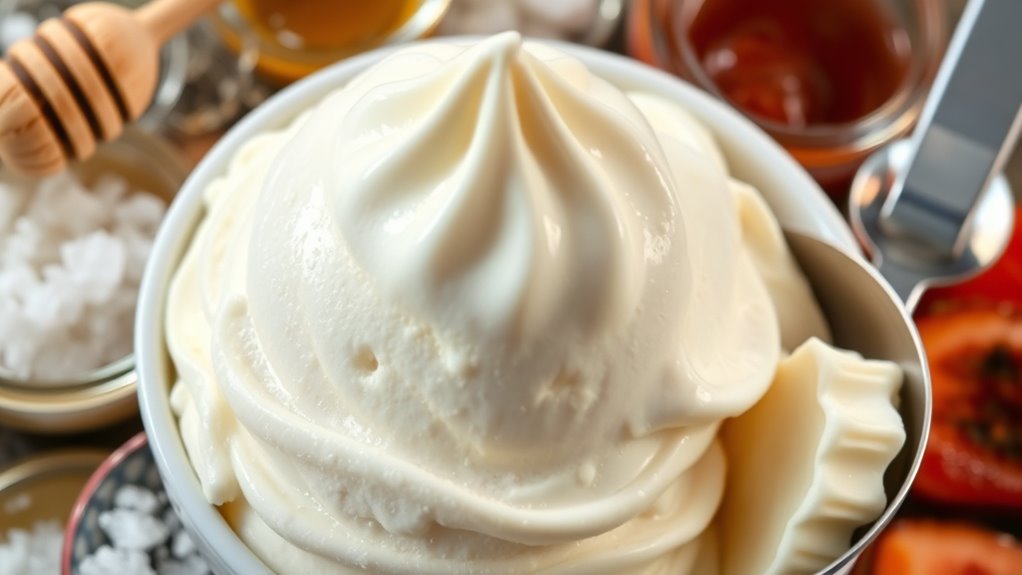
While choosing the right sweeteners for your ice cream, you’ll discover how crucial they’re for enhancing flavor and texture. Sucrose is the go-to option for its balanced sweetness and texture contribution, while sucralose offers a similar flavor profile but is much sweeter. Additionally, incorporating green juice can provide a nutritious boost, enhancing health benefits alongside your sweet treat. Floral arrangements in your serving presentation can also elevate the overall experience. If you’re looking for natural alternatives, stevia and monk fruit sweetener can add unique flavors, though they may introduce some bitterness. Finding the right balance is essential; sweeteners typically make up 12-16% of your mixture. Additionally, incorporating essential oils for flavor can provide a unique twist to your ice cream experience.
Frequently Asked Questions
What Type of Milk Is Best for Ice Cream?
When you’re choosing the best milk for ice cream, consider whole milk and heavy cream as your top choices.
Whole milk strikes a nice balance between fat and solids, while heavy cream adds that rich creaminess you crave.
If you want something creamier, you can use half-and-half or premium dairy.
Just remember, the higher the fat content, the smoother and creamier your ice cream will turn out, so pick wisely!
How Long Should I Churn My Ice Cream?
When you churn your ice cream, the time can really impact its texture.
Generally, you should aim for about 20 to 30 minutes, but it depends on your machine. Keep an eye on it; you want a smooth consistency without large ice crystals.
If you notice it thickening and pulling away from the sides, it’s usually ready. Remember, every machine is different, so adjust based on your specific equipment’s performance.
Can I Use Dairy Alternatives for Ice Cream?
Absolutely, you can use dairy alternatives for ice cream! Coconut milk is a fantastic choice for creaminess, while almond and oat milk offer lighter textures.
Just keep in mind that some alternatives might need thickeners or emulsifiers to achieve that smooth consistency you’re after.
Experimenting with flavors and combinations is a great way to customize your ice cream, plus you’ll have the added benefits of being vegan or lactose-free.
Enjoy your creations!
How Do I Store Leftover Ice Cream?
To store leftover ice cream, start by selecting suitable, secure containers. Seal them tightly to safeguard against freezer burn.
Store your ice cream at the back of the freezer, away from warm air and strong odors. Keep it at a consistent, cold temperature to maintain its creamy consistency.
If it’s melting, don’t refreeze immediately; instead, consider churning it again for the best texture. Enjoy your delicious dessert!
What Is the Ideal Serving Temperature for Ice Cream?
The ideal serving temperature for ice cream is between -10°C to -12°C (14°F to 10°F).
This range helps prevent ice crystal formation, ensuring a smooth, creamy texture.
If you’re serving gelato, aim for a slightly warmer temperature, around 0°C to +6.7°C (32°F to 44°F).
Keeping ice cream at these temperatures enhances its flavor and makes scooping much easier.
Conclusion
Now that you’ve explored the secrets to achieving that perfect scoop texture, remember that ice cream with a fat content of 14-25% yields the creamiest results. You’ve got the tools to balance ingredients, control temperatures, and enhance flavors. Don’t be afraid to experiment with mix-ins and sweeteners to find your unique twist. With practice and patience, you’ll impress everyone with your homemade creations, turning any occasion into a delightful celebration of flavor and texture!



